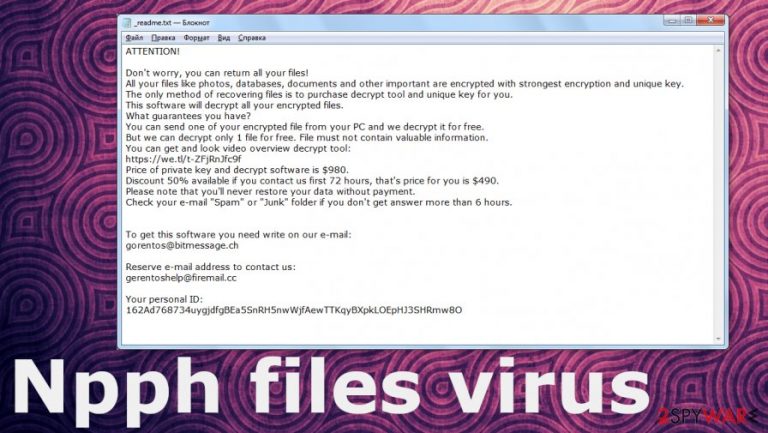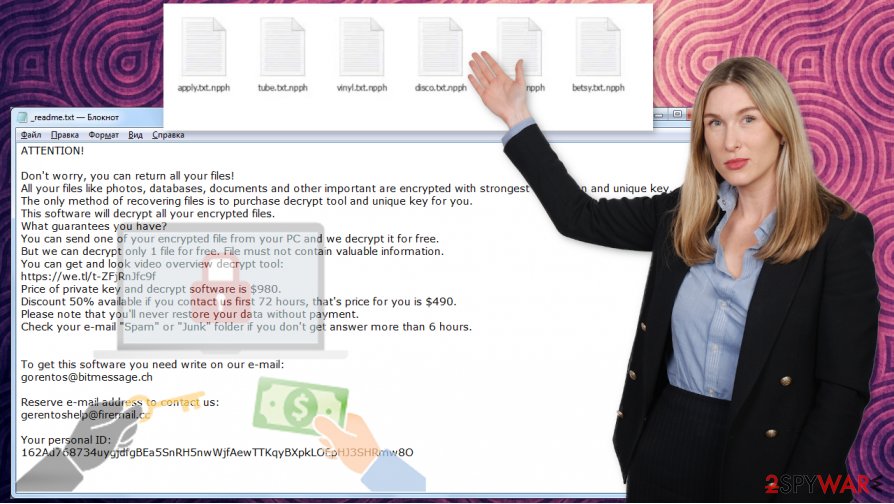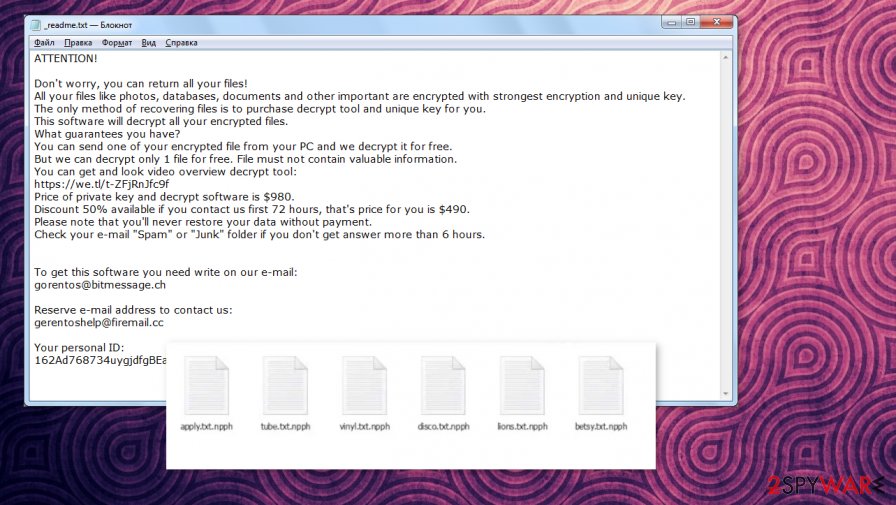Npph ransomware (Virus Removal Guide) - Decryption Steps Included
Npph virus Removal Guide
What is Npph ransomware?
Npph ransomware is the threat that comes from the virus family with 251 different versions already

When the _readme.txt file is delivered to your screen and placed on the desktop, in other folders, you can be sure that the Npph files virus is already running in the background and affecting other parts of the system that control functions and security options. The best way to fight intruders like this could be anti-malware tools, and proper system scans that ensure virus termination. You need to ignore this message, money demands, and avoid contacting criminals entirely. There is no way that your files could be recovered by them. It is the version from a well-known family that is popular and extremely dangerous. Especially after recent improvements and changes made in the encryption and coding that made decryption impossible. This and previous versions like .ogdo, .kasp, or .geno cannot be decrypted or affected files easily recovered, so rely on virus elimination instead.
| Name | Npph ransomware |
|---|---|
| Family | Djvu ransomware that derives from the STOP file-encryption virus |
| Symptoms | The virus attacks commonly used files and trigger the encryption process that locks those images, documents, and data in other formats. Once encryption is done, and file marker .npph gets added at the end of each and one of them. The recovery requires decryption that criminals supposedly should provide |
| Issues | Cybercriminals claim to offer the decryption key for the data restoring after payment in Bitcoin gets transferred. Ransomware creators can damage more on the machine and lead to permanent losses of money or even files |
| Ransom note | _readme.txt – the file that contains a message from virus creators and states about particular money demand, lists contact information |
| Distribution | These threats are mainly distributed with the help of malicious files that get installed from a spam email attachment or via pirated software packages. Macro viruses[2] help with the spreading |
| Contact information | helpmanager@mail.ch, restoremanager@airmail.cc |
| Decryption | Possible options for this version are limited because the Npph files virus relies on online ID generation. This method means that every victim gets the unique key needed for decryption and it becomes even more difficult to restore files. You can try to repair media files or rely on the possibility with Emsisoft Djvu decryptor |
| Elimination | Npph ransomware removal process is the one that needs anti-malware tools for the best results. Tools like that can detect malware, all the ransomware traces and clear the machine before the file recovery |
| System repair | You should note that the machine gets significantly damaged when the threat like this runs in the background. There are many parts of the system folders, functions, programs that ransomware manages to alter. Run FortectIntego to repair at least some of them |
Npph virus is the threat that triggers setting changes to ensure persistence, so it is not only locking files, but it creates issues with the performance, programs, security options, and recovery solutions. Virus creators focus on RSA and AES cryptography, so targeted personal files get locked without many options to recover them. The decryption is not the only possible solution. Especially when criminals promise to provide a tool that might not even exist.
Experts[3] often talk about the dangerous ransomware-type threats that can damage your files, and Npph ransomware virus is not an exception. It makes users data encoded, so the message can be delivered. But the file name, message contents, even the contact information remain the same for a while now. You shouldn't fall for this trick and try to remove the threat instead.
The message from Npph ransomware creators deliver the following message:
ATTENTION!
Don't worry, you can return all your files!
All your files like photos, databases, documents and other important are encrypted with strongest encryption and unique key.
The only method of recovering files is to purchase decrypt tool and unique key for you.
This software will decrypt all your encrypted files.
What guarantees you have?
You can send one of your encrypted file from your PC and we decrypt it for free.
But we can decrypt only 1 file for free. File must not contain valuable information.
You can get and look video overview decrypt tool:
hxxps://we.tl/t-ccUfUrQOhF
Price of private key and decrypt software is $980.
Discount 50% available if you contact us first 72 hours, that's price for you is $490.
Please note that you'll never restore your data without payment.
Check your e-mail “Spam” or “Junk” folder if you don't get answer more than 6 hours.To get this software you need write on our e-mail:
helpmanager@mail.chReserve e-mail address to contact us:
restoremanager@airmail.ccYour personal ID:
When you encounter files marked with .npph appendix, you can know that the file is not going to be restored to a normal state. It is not possible because the original code is altered, and the only way to revert the procedure is by getting the particular key from criminals. This newly discovered .Npph ransomware is not like the previous versions that came in 2019, so this is pretty much impossible. Online IDs got used as primarily back in August 2019, so form there on Djvu versions are no longer decrypted.

Npph ransomware encrypted file recovery options
As we mentioned there is no need to contact criminals, it is better to remove Npph ransomware first and then focus on options for file recovery. The machine gets significantly affected when cryptovirus manages to inject its payload and other programs or files on the system.
Npph ransomware generates a particular ID fort each victim, so the connection with a C&C server is needed for this online key formation procedure. However, this is a bad fact for virus victims. The virus can be removed when you use tools like SpyHunter 5Combo Cleaner or Malwarebytes. It is not that difficult, you need a proper AV detection engine tool and full scan on the system, so all traces get detected and terminated.
Unfortunately, data recovery is not that easy. It is not the same as Npph ransomware removal because of the online IDs vs. offline IDs functions and additional damage done on the computer. Old variants of the threat can be decrypted, but since criminals release new versions weekly there are little to no chances that you will get the old variant on the machine.
Especially when distribution ways of Npph file virus got changed from the initial Djvu versions too. Right now, the main way of the distribution includes pirating and torrent sites, malicious files included with those licensed program versions or software cracks, game cheats. Pay attention to such content because you can never know what you get.

Shady .npph virus distribution leads to data loss
It is known that .npph ransomware, as other versions in this ransomware family spread using malicious files that get attached to email notifications as files or downloaded from malicious links to shady sites. You should pay attention to all the details, so you can avoid any interference with the system functions and additional programs.
You can definitely report the distribution of a malicious Npph virus as a criminal act. This ransom demanding while holding the property is considered illegal in many countries. Of course, such behavior is most likely not going to improve the performance or help with files. You still can lose your data permanently if there are no particular backups that could be used for file restoring.
If the decrypted is obtained from criminals or the particular researchers that analyze the .npph file virus attack and behavior, you can recover those encrypted files. However, it takes time for malware experts to build the tool, and criminals are not worthy of the trust. There is little to no possibility that your files can be restored soon. Cryptocurrency extortionists focus on getting money from people instead of meeting their needs and recovering files.
DO NOT PAY. Remove the Npph virus instead and try to repair files with the use of your backups, or third-party programs that offer such an option. You can find a few options below. Do not fall for the trick of malicious actors, that distribute other threats passing as decryption tool creators.
.Npph file virus termination – full system cleaning
You should focus on the proper Npph ransomware virus elimination as soon as you find the threat affecting your files or once you get the money demanding message on the desktop. The best way to achieve the proper cleaning of the machine – virus-fighting programs.
Tools like SpyHunter 5Combo Cleaner or Malwarebytes are the ones that can remove Npph ransomware for you and without any other issues. You can rely on the anti-malware program and allow the tool to check all the parts of the machine for you. Once the system scan is done, you should delete all detected threats automatically. If you gave issues with the launch of the AV tool – reboot the computer in Safe Mode first.
Npph ransomware removal is not going to recover your encrypted files, unfortunately. For that, you need a tool capable of repairing data or backups stored on proper cloud service or external devices. If you do not have reliable backups, try the tools listed below. But ensure that the machine is recovered with FortectIntego or a different optimizer tool.
Getting rid of Npph virus. Follow these steps
Manual removal using Safe Mode
Reboot the machine in a Safe Mode with Networking, so the virus can get eliminated properly
Important! →
Manual removal guide might be too complicated for regular computer users. It requires advanced IT knowledge to be performed correctly (if vital system files are removed or damaged, it might result in full Windows compromise), and it also might take hours to complete. Therefore, we highly advise using the automatic method provided above instead.
Step 1. Access Safe Mode with Networking
Manual malware removal should be best performed in the Safe Mode environment.
Windows 7 / Vista / XP
- Click Start > Shutdown > Restart > OK.
- When your computer becomes active, start pressing F8 button (if that does not work, try F2, F12, Del, etc. – it all depends on your motherboard model) multiple times until you see the Advanced Boot Options window.
- Select Safe Mode with Networking from the list.

Windows 10 / Windows 8
- Right-click on Start button and select Settings.

- Scroll down to pick Update & Security.

- On the left side of the window, pick Recovery.
- Now scroll down to find Advanced Startup section.
- Click Restart now.

- Select Troubleshoot.

- Go to Advanced options.

- Select Startup Settings.

- Press Restart.
- Now press 5 or click 5) Enable Safe Mode with Networking.

Step 2. Shut down suspicious processes
Windows Task Manager is a useful tool that shows all the processes running in the background. If malware is running a process, you need to shut it down:
- Press Ctrl + Shift + Esc on your keyboard to open Windows Task Manager.
- Click on More details.

- Scroll down to Background processes section, and look for anything suspicious.
- Right-click and select Open file location.

- Go back to the process, right-click and pick End Task.

- Delete the contents of the malicious folder.
Step 3. Check program Startup
- Press Ctrl + Shift + Esc on your keyboard to open Windows Task Manager.
- Go to Startup tab.
- Right-click on the suspicious program and pick Disable.

Step 4. Delete virus files
Malware-related files can be found in various places within your computer. Here are instructions that could help you find them:
- Type in Disk Cleanup in Windows search and press Enter.

- Select the drive you want to clean (C: is your main drive by default and is likely to be the one that has malicious files in).
- Scroll through the Files to delete list and select the following:
Temporary Internet Files
Downloads
Recycle Bin
Temporary files - Pick Clean up system files.

- You can also look for other malicious files hidden in the following folders (type these entries in Windows Search and press Enter):
%AppData%
%LocalAppData%
%ProgramData%
%WinDir%
After you are finished, reboot the PC in normal mode.
Remove Npph using System Restore
Rely on System Restore feature and remove Npph ransomware
-
Step 1: Reboot your computer to Safe Mode with Command Prompt
Windows 7 / Vista / XP- Click Start → Shutdown → Restart → OK.
- When your computer becomes active, start pressing F8 multiple times until you see the Advanced Boot Options window.
-
Select Command Prompt from the list

Windows 10 / Windows 8- Press the Power button at the Windows login screen. Now press and hold Shift, which is on your keyboard, and click Restart..
- Now select Troubleshoot → Advanced options → Startup Settings and finally press Restart.
-
Once your computer becomes active, select Enable Safe Mode with Command Prompt in Startup Settings window.

-
Step 2: Restore your system files and settings
-
Once the Command Prompt window shows up, enter cd restore and click Enter.

-
Now type rstrui.exe and press Enter again..

-
When a new window shows up, click Next and select your restore point that is prior the infiltration of Npph. After doing that, click Next.


-
Now click Yes to start system restore.

-
Once the Command Prompt window shows up, enter cd restore and click Enter.
Bonus: Recover your data
Guide which is presented above is supposed to help you remove Npph from your computer. To recover your encrypted files, we recommend using a detailed guide prepared by 2-spyware.com security experts.If your files are encrypted by Npph, you can use several methods to restore them:
Windows Previous Versions is the method possibly useful for file recovery after the Npph ransomware attack
You can recover files with this feature if you rely on System Restore first
- Download Data Recovery Pro;
- Follow the steps of Data Recovery Setup and install the program on your computer;
- Launch it and scan your computer for files encrypted by Npph ransomware;
- Restore them.
Data Recovery Pro – proper program that provides the file option after encryption
You can restore accidentally deleted files or encrypted data using this program
- Find an encrypted file you need to restore and right-click on it;
- Select “Properties” and go to “Previous versions” tab;
- Here, check each of available copies of the file in “Folder versions”. You should select the version you want to recover and click “Restore”.
ShadowExplorer – a method for file restoring
When Npph ransomware or other intruders leave Shadow Volume Copies alone, you can recover affected files
- Download Shadow Explorer (http://shadowexplorer.com/);
- Follow a Shadow Explorer Setup Wizard and install this application on your computer;
- Launch the program and go through the drop down menu on the top left corner to select the disk of your encrypted data. Check what folders are there;
- Right-click on the folder you want to restore and select “Export”. You can also select where you want it to be stored.
Npph ransomware decryption can be possible
Some of the versions in this ransomware family can be decrypted when Emsisofts' decryption tool states that it is possible
Finally, you should always think about the protection of crypto-ransomwares. In order to protect your computer from Npph and other ransomwares, use a reputable anti-spyware, such as FortectIntego, SpyHunter 5Combo Cleaner or Malwarebytes
How to prevent from getting ransomware
Do not let government spy on you
The government has many issues in regards to tracking users' data and spying on citizens, so you should take this into consideration and learn more about shady information gathering practices. Avoid any unwanted government tracking or spying by going totally anonymous on the internet.
You can choose a different location when you go online and access any material you want without particular content restrictions. You can easily enjoy internet connection without any risks of being hacked by using Private Internet Access VPN.
Control the information that can be accessed by government any other unwanted party and surf online without being spied on. Even if you are not involved in illegal activities or trust your selection of services, platforms, be suspicious for your own security and take precautionary measures by using the VPN service.
Backup files for the later use, in case of the malware attack
Computer users can suffer from data losses due to cyber infections or their own faulty doings. Ransomware can encrypt and hold files hostage, while unforeseen power cuts might cause a loss of important documents. If you have proper up-to-date backups, you can easily recover after such an incident and get back to work. It is also equally important to update backups on a regular basis so that the newest information remains intact – you can set this process to be performed automatically.
When you have the previous version of every important document or project you can avoid frustration and breakdowns. It comes in handy when malware strikes out of nowhere. Use Data Recovery Pro for the data restoration process.
- ^ My company got hit today with a djvu virus ,, all files got encrypted with .kasp extension. Reddit. Online community forum.
- ^ Macro virus. Wikipedia. The free encyclopedia.
- ^ Dieviren. Dieviren. Spyware related news.







